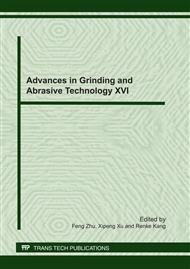p.1
p.6
p.11
p.16
p.24
p.29
p.34
p.39
Temperatures in Grinding Cemented Carbide (YT30) with a Vacuum Brazed Diamond Wheel
Abstract:
An experimental investigation is reported on the temperatures and energy partitions involved in the grinding of cemented carbide (YT30) with a vacuum brazed diamond wheel. The grinding temperature at the wheel-workpiece interface was measured using a pair of grindable foil thermocouples and the energy partition to the workpiece was evaluated by matching the analytical temperatures to the measured results. Effects of the various grinding conditions, including wheel velocity, feed rate and depth of cut, on the temperatures and the energy partition were investigated. It was determined that the wheel velocity was the most significant factor in governing the temperature relative to the depth of cut and feed rate. The maximum temperature rise at the contact zone was below 25°C in the present study. Microscopic examination of the ground surfaces and the ground detritus revealed that brittle fracture was the dominant material-removal mode. This may be one of the reasons for the low grinding temperature in grinding YT30 with a vacuum brazed diamond wheel. The energy partition values to the workpiece obtained under different grinding conditions varied from 3.3% to 20% for dry grinding YT30.
Info:
Periodical:
Pages:
16-23
Citation:
Online since:
July 2011
Authors:
Keywords:
Price:
Сopyright:
© 2011 Trans Tech Publications Ltd. All Rights Reserved
Share:
Citation:


